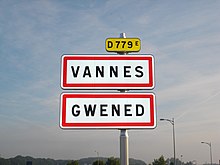Breton language
It is the only Celtic language still widely in use on the European mainland, albeit as a member of the insular branch instead of the continental grouping.[6] Breton was brought from Great Britain to Armorica (the ancient name for the coastal region that includes the Brittany peninsula) by migrating Britons during the Early Middle Ages, making it an Insular Celtic language.[citation needed] Having declined from more than one million speakers around 1950 to about 200,000 in the first decade of the 21st century, Breton is classified as "severely endangered" by the UNESCO Atlas of the World's Languages in Danger.The revolutionaries assumed that reactionary and monarchist forces preferred regional languages to try to keep the peasant masses under-informed.In 1794, Bertrand Barère submitted his "report on the patois" to the Committee of Public Safety in which he said that "federalism and superstition speak Breton".[10] Since the 19th century, under the Third, Fourth and now Fifth Republics, the French government has attempted to stamp out minority languages—including Breton—in state schools, in an effort to build a national culture.[13] Its publication encouraged the creation of original literature in all genres, and proposed Breton translations of internationally recognized foreign works.Some other popular comics have also been translated into Breton, including The Adventures of Tintin, Spirou, Titeuf, Hägar the Horrible, Peanuts and Yakari.Today bilingual dictionaries have been published for Breton and languages including English, Dutch, German, Spanish and Welsh.Efforts include installing bilingual signs and posters for regional events, as well as encouraging the use of the Spilhennig to let speakers identify each other.The office also started an Internationalization and localization policy asking Google, Firefox[18] and SPIP to develop their interfaces in Breton.France has twice chosen to enter the Eurovision Song Contest with songs in Breton; once in 1996 in Oslo with "Diwanit bugale" by Dan Ar Braz and the fifty piece band Héritage des Celtes, and most recently in 2022 in Turin with "Fulenn" by Alvan Morvan Rosius and vocal trio Ahez.They are leoneg (léonard, of the county of Léon), tregerieg (trégorrois, of Trégor), kerneveg (cornouaillais, of Cornouaille), and gwenedeg (vannetais, of Vannes).[28] In the late 20th century, the French government considered incorporating the independent Breton-language immersion schools (called Diwan) into the state education system.In 2018, 18,337[1] pupils (about 2% of all students in Brittany) attended Diwan, Div Yezh and Dihun schools, and their number has increased yearly.An emergence of a schwa sound occurs as a result of vowel neutralization in post-tonic position, among different dialects.Although modern Breton has lost its ancestral dual number marker, relics of its use are preserved in various nouns pertaining to body parts, including the words for eyes, ears, cheeks, legs, armpits, arms, hands, knees, thighs, and wings.The (etymologically) already dual words for eyes (daoulagad) and ears (divskouarn) can be pluralized "again" to form daoulagadoù and diskouarnoù.[45][44] As seen elsewhere in many Celtic languages, the formation of the plural can be hard to predict, being determined by a mix of semantic, morphological and lexical factors.These include placʼh "girl" → mercʼhed, porcʼhell "pig" → mocʼh, buocʼh "cow" → saout, and ki "dog" → chas.[44] As in other Celtic languages as well as English, a variety of verbal constructions is available to express grammatical aspect, for example: showing a distinction between progressive and habitual actions: As in other modern Celtic languages, Breton pronouns are fused into preceding prepositions to produce a sort of inflected preposition.Normal word order, like the other Insular Celtic languages, is at its core VSO (verb-subject-object), which is most apparent in embedded clauses.[45] The first extant Breton texts, contained in the Leyde manuscript, were written at the end of the 8th century: 50 years prior to the Strasbourg Oaths, considered to be the earliest example of French.During the early years of the 20th century, a group of writers known as Emglev ar Skrivanerien elaborated and reformed Le Gonidec's system.At the same time writers of the more divergent Vannetais dialect developed a phonetic system also based on that of Le Gonidec.This Peurunvan ("wholly unified") orthography was significant for the inclusion of the digraph ⟨zh⟩, which represents a /h/ in Vannetais and corresponds to a /z/ in the KLT dialects.In addition, Peurunvan maintains the KLT convention, which distinguishes noun/adjective pairs by nouns written with a final voiced consonant and adjectives with a voiceless one.The French word baragouiner ("to jabber in a foreign language") is derived from Breton bara ("bread") and gwin ("wine").The French word goéland ("large seagull") is derived from Breton gwelan, which shares the same root as English "gull" (Welsh gwylan, Cornish goelann).






HuelgoatBrittanyFranceLower BrittanyBretonsÎle-de-FranceLanguage familyIndo-EuropeanCelticInsular CelticBrittonicSouthwestern BrittonicGwenedegTregeriegWriting systemLatin scriptRegulated byOfis Publik ar BrezhonegISO 639-1ISO 639-2ISO 639-3Linguist ListGlottologLinguasphereAtlas of the World's Languages in DangerUnicodeendonymMorbihanSouthwestern Brittonic languageCeltic language groupinsularcontinentalGreat BritainArmoricaBritonsEarly Middle AgesInsular Celtic languageCornishCumbricWestern Brittonic languagesGoidelic languagesScottish GaelicLinguistic boundary of BrittanyPlouhaSaint-BrieucLa Roche-BernardVannesGaliciabourgeoisieFrenchDuchy of BrittanyBreton literaturephilosophicalminoritylanguages of FranceFrench Revolutionpatoisreactionarymonarchistregional languagesBertrand BarèreCommittee of Public SafetyFourthFifth Republicsendangered languagemonolingualRoparz HemonGwalarnAl LiammDiwan schoolsimmersionAsterixGaulishArmorica peninsulaThe Adventures of TintinSpirouTiteufHägar the HorriblePeanutsYakariRadio KerneFinistèreLancelot du LacShakespeare in LoveColumboPerry MasonYann-Ber KallocʼhAñjela DuvalXavier de LanglaisPêr-Jakez HeliasYouenn GwernigGlenmorVefa de Saint-PierreAlan StivellCeltic languageCatholiconSpilhennigInternationalization and localizationGoogleFirefoxBreton WikipediaRegional Council of BrittanyMicrosoftFacebookEurovision Song ContestDan Ar BrazHéritage des CeltesFulennAlvan Morvan Rosiusminority languagesAntillean CreoleCorsicancounty of LéontrégorroisTrégorCornouailleGuérandeBatz-sur-Merdialect continuumCarhaixLanguage policy of Franceofficial languageFrench ConstitutionEuropean Charter for Regional or Minority LanguagesSenateGwened